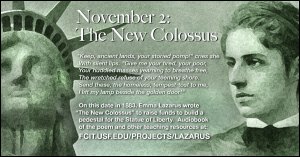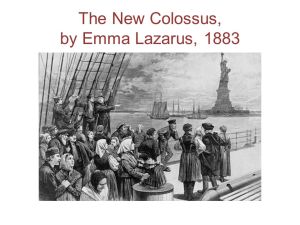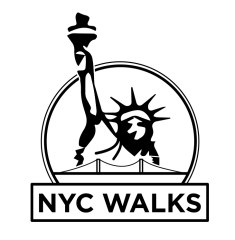Emma Lazarus and the Brooklyn Bridge

Emma Lazarus, the daughter of Moses and Esther Nathan, one of the oldest Jewish families in New York City, was born there on July 22, 1849, and died on November 19, 1887. She was privately educated by tutors and published her first poems during her early teens. These attracted the attention of Ralph Waldo Emerson, to whom she dedicated her second book of poems. A number of her poems and essays were published in Scribner’s Monthly, the Century, Lippincott’s Magazine, and The Critic. By the time Lazarus turned twenty, the population of New York City had more than doubled, to over a million people. She was a welcomed part of the cultural elite and traveled extensively throughout Europe.
By the early 1880s, New York was not only the cultural hub of America; it was also the destination point for thousands of Jewish immigrants escaping the Pogroms of Russia in. the1880’s. At that time, Lazarus also became one of the most outspoken Americans on Jewish issues. She used her celebrity to bring attention to the idea of the resettlement of Jews in Palestine. Lazarus became known for defending the oppressed and organizing relief efforts for refugees at Ward’s Island now known as Roosevelt Island. She created classes for Jewish immigrants to learn and helped to find them housing in an overcrowded city. She started an organization called the Society for the Improvement and Colonization of East European Jews. She wrote articles on Jewish history and cultural life that were published for both Christian and Jewish readers.

A statue called, “Liberty Enlightening the World,” honoring two nations who achieved liberty through revolution, had been a gift from France. It was presented to America as an exhibition at the 1876 Centennial Fair in Philadelphia. When no rich patron stepped forward to provide money to erect the Statue of Liberty at Bedloe’s Island, now Liberty Island, Joseph Pulitzer, the publisher declared that anyone donated even a penny, his or her name would be published in his New York newspaper, The New York World. As a consequence, Joseph Pulitzer pioneered “crowdsourcing.”

The New Colossus, by Emma Lazarus, 1883
Joseph Pulitzer also set a committee to reach out to the cultural elite to donate artistic or literary efforts for auction. In 1883, Lazarus’s contribution was solicited by fundraiser William Maxwell Evarts. Initially, she refused but Constance Cary Harrison convinced her that the statue would be of great significance to immigrants sailing into the harbor. Emma Lazarus wrote “The New Colossus” in 1883 for an auction “In Aid of the Bartholdi Pedestal Fund.” “The New Colossus” was the first entry read at the exhibit’s opening. Then, the poem was auctioned off for $1,500, the equivalent of over $33.000 in 2015 dollars. The poem was forgotten and played no role four years later at the unveiling of the statue. President Grover Cleveland, in his 1886 dedication of Lady Liberty; declared that her light would, “pierce the darkness of man’s ignorance and oppression.”
The Brooklyn Bridge opened to the public in May 1883 – the year the poem was composed. Carol Rumens analyzes that “[I]t likely that Lazarus wanted to convey the thrilling new sight of this great suspension bridge, and that “air-bridged” is a compressed allusion to the wonderful “airiness” of the construction: therefore, the city is Brooklyn.”” https://www.theguardian.com/books/2012/jun/04/poem-week-new-colossus-emma-lazarus The reference to “twin cities” refers that Brooklyn was an independent city on Long Island until its merger with 39 other municipalities in 1898 to form greater New York.
Emma Lazarus’s poem fell away into obscurity. Outspoken in life, her embarrassed family scrambled to fit her memory into a more demure and feminine ideal. In 1901, Lazarus’s friend Georgina Schuyler began an effort to memorialize Lazarus and her poem, which succeeded in 1903, sixteen years after her death, when a plaque bearing the text of the poem was put on the inner wall of the pedestal of the Statue of Liberty as a memorial. Another version is that the poem was rediscovered in a published catalog in a used bookstore and the reader campaigned to get the poem put on the statue.
The New Colossus by Emma Lazarus (1883)
- Not like the brazen giant of Greek fame
- With conquering limbs astride from land to land;
- Here at our sea-washed, sunset gates shall stand
- A mighty woman with a torch, whose flame
- Is the imprisoned lightning, and her name
- Mother of Exiles. From her beacon-hand
- Glows world-wide welcome; her mild eyes command
- The air-bridged harbor that twin cities frame,
- “Keep, ancient lands, your storied pomp!” cries she
- With silent lips. “Give me your tired, your poor,
- Your huddled masses yearning to breathe free,
- The wretched refuse of your teeming shore,
- Send these, the homeless, tempest-tossed to me,
- I lift my lamp beside the golden door!”
To learn more, go to https://jwa.org/womenofvalor/lazarus
NYC Walks Blog 41 Emma Lazarus and the Brooklyn Bridge © 2018 by Dr. Philip Ernest Schoenberg
